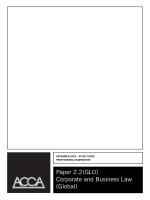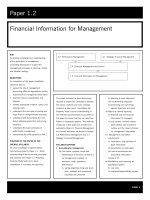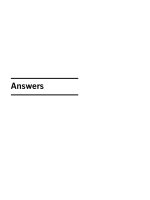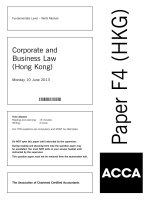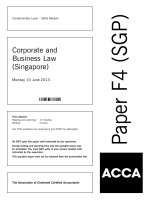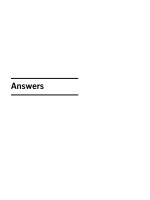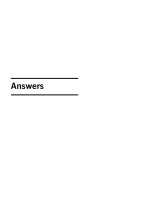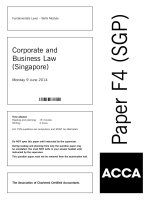acca test book Corporate and Business Law Financial Information for Management pptx
Bạn đang xem bản rút gọn của tài liệu. Xem và tải ngay bản đầy đủ của tài liệu tại đây (350.82 KB, 7 trang )
PAGE 3
AIM
To develop knowledge and understanding
of the application of management
accounting techniques to support the
management processes of planning, control
and decision making.
OBJECTIVES
On completion of this paper candidates
should be able to:
• explain the role of management
accounting within an organisation and the
requirement for management information
• describe costs by classification and
purpose
• identify appropriate material, labour and
expense costs
• understand the principles of costing and
apply them in straightforward scenarios
• understand and demonstrate the cost
factors affecting production and pricing
decisions
• understand the basic principles of
performance management
• demonstrate the skills expected in Part 1.
POSITION OF THE PAPER IN THE
OVERALL SYLLABUS
No prior knowledge is required before
commencing study for Paper 1.2. Some
understanding of the accounting principles
and practices from Paper 1.1 Preparing
Financial Statements and a basic
competence in numeracy are assumed.
This paper provides the basic techniques
required to enable the candidate to develop
the various methods into more complex
problems at later parts. Candidates will,
therefore, need a sound understanding of
the methods and techniques encountered in
this paper to ensure that they can take them
further in subsequent papers. The methods
introduced in this paper are revisited and
extended in Paper 2.4 Financial Management
and Control and taken yet further in Papers
3.3 Performance Management and 3.7
Strategic Financial Management.
SYLLABUS CONTENT
1 Accounting for management
(a) The nature, purpose, scope and
interrelations of functions carried out
by management in relation to
resources, costs, operations,
performance
(i) setting objectives (long and short-
term, strategic and operational,
corporate and personal)
(ii) planning to meet objectives
(iii) implementing objectives
(iv)monitoring and controlling
against objectives and plans
(b) Nature of internal reporting
(i) financial and non-financial
information for managers
(ii) cost centres, revenue centres,
profit centres and investment
centres and the impact of these
on management information.
(c) Management information
requirements
(i) importance and definition of
good information
(ii) presentation of information
(iii) role of accountants and
accounting information
(iv)role of IT.
(d) Maintaining and improving an
appropriate system
(i) cost units
(ii) cost/profit/responsibility centres
Financial Information for Management
Paper 1.2
3.3 Performance Management
3.7 Strategic Financial Management
2.4 Financial Management and Control
1.2 Financial Information for Management
PAGE 4
Paper 1.2: Financial Information for Management (Continued)
(iii) methods for recording relevant
information
(iv)sources of information and
recording/processing information
(v) computer based information,
storage and processing
(vi)analysis of output information
and its dissemination to relevant
individuals/departments.
2 Cost accounting
(a) Cost accounting versus management
accounting
(i) purposes of cost and management
accounting and financial accounting
(ii) role of cost accounting in a
management information system
(iii) non-financial information.
(b) Nature and purpose of cost
classification and definitions.
3 Elements of cost
(a) Materials
(i) standard and actual costs for
materials including the use of
FIFO, LIFO and weighted average
for material valuation and the
pricing of material issues
(ii) optimal purchase quantities to
include discounts
(iii) optimal batch quantities
(iv)reorder levels
(v) material losses.
(b) Labour
(i) direct and indirect labour
(ii) different remuneration methods
(iii) labour efficiency
(iv)labour turnover.
(c) Overheads
(i) direct and indirect expenses
(ii) principles and processes of
overhead cost analysis
(iii) allocation and apportionment of
overhead costs including reciprocal
service centre situations
(iv)absorption rates
(v) under- and over -absorption
(vi)fixed overhead expenditure and
volume variances
(vii) fixed overhead efficiency and
capacity variances where
appropriate
(viii) changes in the cost structure of
a business over time.
4 Costing systems
(a) Job, batch and process costing
(i) characteristics
(ii) direct and indirect costs
(including waste, scrap and
rectification costs)
(iii) valuation of process transfers
and work-in-progress using
equivalent units of production
and based on FIFO and weighted
average pricing methods
(iv) process costing normal losses,
abnormal losses and gains
(v) joint and by-products in process
costing
(b) Operation/service costing
(i) scope of operation/service costing
(ii) appropriate cost units
(iii) collection, classification and
ascertainment of costs.
5 Costing methods and techniques
(a) Standard costing
(i) establishment of standard costs
(ii) variance analysis
(iii) explanations of variances and
control
(iv) implications for management
(v) operating statements.
(b) Marginal and absorption costing
(i) marginal and absorption costing
profit and loss accounts
(ii) reconciliation of the profits under
the two methods
(iii) contrast of absorption and
marginal costing
6 Short-term decision making
(a) Cost behaviour
(i) fixed, variable and semi-variable
costs
(ii) cost behaviour using an
appropriate graph
(iii) high-low method
(iv) regression analysis.
(b) CVP analysis
(i) break-even point and revenue
(ii) margin of safety
(iii) target profit
(iv) contribution to sales ratio
(v) break-even chart and profit/
volume graph.
(c) Limiting factors
Financial Information for Management (Continued)
PAGE 5
(i) optimal production plan given a
scarce resource
(ii) linear programming techniques
(iii) other methods for more than two
variable problems.
(d) Preparation of cost estimates for
decision making
(i) relevant costing techniques to
include opportunity/sunk,
avoidable/unavoidable, fixed/
variable applied to such
situations as make or buy, shut
down and one-off contracts.
(e) Pricing of goods and services
(i) price/demand relationships
(ii) full cost plus pricing
(iii) marginal costing.
(f) Price skimming, penetration pricing,
premium pricing and price
discrimination.
EXCLUDED TOPICS
The syllabus content outlines the areas for
assessment. No areas of knowledge are
specifically excluded from the syllabus.
KEY AREAS OF THE SYLLABUS
The key topic areas are:
• cost classification and behaviour
• material, labour and overhead costs
• absorption and marginal costing
• process costing
• standard costing
• CVP analysis
• pricing methods.
APPROACH TO EXAMINING THE
SYLLABUS
The examination is a three hour paper
constructed in two sections. Both sections
will draw from all parts of the syllabus and
will contain both computational and
discursive elements.
Number
of Marks
Section A: 25 compulsory multiple
choice questions (2 marks each) 50
Section B: 5 compulsory short form
questions (8-12 marks each) 50
100
Paper 1.2 can also be taken as a three
hour computer based examination.
ADDITIONAL INFORMATION
Formulae as required are included in the
formulae sheet given in the exam.
RELEVANT TEXTS
There are a number of sources from which
you can obtain a series of materials written
for the ACCA examinations. These are
listed below:
Foulks Lynch – ACCA's official publisher
Contact number: +44 (0)20 8831 9990.
Website: www.foulkslynch.com
Accountancy Tuition Centre (ATC)
International
Contact number: +44 (0)141 880 6469.
Website: www.ptc-global.com
BPP
Contact number: +44 (0)20 8740 2211.
Website: www.bpp.com
The Financial Training Company
Contact number: +44 (0)174 785 4302.
Website: www.financial-training.com
The following texts are also recommended
as study material for this paper:
G Bancroft, G O’Sullivan Quantitative
Methods for Accounting and Business
Studies (3rd Edition) McGraw Hill
ISBN 0077077318
C Drury Management and Cost
Accounting (5th Edition) International
Thomson Business Press
ISBN 1861525362.
Wider reading is also desirable, especially
regular study of relevant articles in ACCA's
student accountant.
Financial Information for Management (Continued)
PAGE 6
Financial Information for Management (Continued)
STUDY SESSIONS
1 Information for Management
(a) Distinguish between ‘data’ and
‘information’
(b) Describe the sources of information
(c) Identify and explain the attributes of
good information
(d) Describe the methods of recording
and processing information
(e) Describe the ways in which data
could be presented to management.
2 Management Information Systems
(a) Explain what is meant by a
management information system
(b) Explain the role of accountants and
accounting information within a
management information system
(c) Describe the purpose and role of
cost and management accounting
within a management information
system
(d) Compare and contrast financial and
cost and management accounting
(e) Outline the managerial processes of
planning, decision-making and
control
(f) Discuss the management of both
financial and non-financial
information requirements
(g) Describe the various types of
responsibility centres and the impact
of these on management
information.
3 Objectives, Strategy and Planning
(a) Define the terms ‘objectives’ and
‘strategy’
(b) Describe the different objectives for
different types of organisations
(c) Illustrate the links between strategy
and organisational structure
(d) Explain how the objectives and
strategy
of an organisation impact upon its plans
(e) Describe the planning process
(f) Describe the main techniques used
in the planning and decision making
process for various types of organisation
(g) Explain the difference between
strategic, tactical and operational
planning
(h) Describe the basic elements of and
purpose of a management control
system
(i) Illustrate the need for monitoring
and evaluation
(j) Describe methods for monitoring and
controlling against objectives and
plans.
4 The Role of Information Technology in
Management Information
(a) Identify the characteristics and
different types of computer hardware
and software
(b) Evaluate the potential value of
computer systems in handling and
processing business data
(c) Describe methods of capturing and
processing data by computer
(d) Describe how data is grouped,
tabulated, stored and output
(e) Explain the role and features of
spreadsheet systems
(f) Describe how output could be
analysed and used within an
organisation.
5 Cost Classification
(a) Explain and illustrate classifications
used in the analysis of product/
service costs including by function,
direct and indirect, product and
period, fixed and variable, avoidable
and unavoidable, controllable and
uncontrollable
(b) Explain and illustrate the concept of
cost objects, cost units, cost centres,
revenue centres, profit centres and
investment centres
(c) Describe briefly the process of
accounting for input costs and
relating them to work done
(d) Describe briefly the different
methods of costing final outputs and
their appropriateness to different
types of business organisation/
situation
(e) Describe the nature of control
achieved through the comparison of
actual costs against plan.
6 Cost Behaviour - 1
(a) Explain the importance of cost
behaviour in relation to business
decision-making
PAGE 7
Financial Information for Management (Continued)
(b) Describe factors which influence cost
behaviour
(c) Explain how the terms linear, curvi-
linear and step functions apply to
costs
(d) Identify, describe and illustrate
graphically different types of cost
behaviour
(e) Explain the structure of linear
functions and equations
(f) Provide examples of costs which
contain both fixed and variable
elements
(g) Use high/low analysis to separate
the fixed and variable elements of
such costs
7 Cost behaviour - 2
(a) Construct a scatter graph to
establish whether a linear function
would be appropriate
(b) Establish a linear function using
regression analysis and interpret the
results
(c) Calculate and explain the concepts
of correlation and coefficient of
determination.
8 Material Costs – 1
(a) Describe the different procedures
and documents necessary for
ordering, receiving and issuing
materials from stock
(b) Describe the control procedures used
to monitor physical and ‘book’ stock
and to minimise discrepancies and
losses
(c) Calculate, explain and evaluate the
value of closing stock and material
issues using LIFO, FIFO and average
methods (weighted and periodic)
(d) Calculate the standard cost of stocks
from given information
(e) Prepare ledger entries to record
material cost inputs and outputs
(f) Interpret the entries and balances in
the material stock account.
9 Material Costs – 2
(a) Explain the reasons for holding stock
(b) Identify and explain the costs of
having stock
(c) Calculate and interpret optimal
reorder quantities
(d) Calculate and interpret optimal
reorder quantities when discounts
apply
(e) Produce and interpret calculations to
minimise stock costs when stock is
gradually replenished
(f) Describe appropriate methods for
establishing reorder levels.
10 Labour Costs
(a) Explain the difference between, and
calculate, direct and indirect labour
costs
(b) Explain the methods used to relate
input labour costs to work done
(c) Prepare journal and ledger entries to
record labour cost inputs and
outputs
(d) Describe and illustrate different
remuneration methods and incentive
schemes
(e) Calculate the level, and analyse the
costs and causes of, labour turnover
(f) Describe and illustrate measures of
labour efficiency and utilisation
(g) Interpret the entries and balances in
the labour account.
11 Overheads – 1
(a) Explain the difference between the
treatment of direct and indirect
expenses
(b) Describe and justify the process of
apportioning manufacturing
overhead costs incurred to
production
(c) Allocate and apportion factory
overheads using an appropriate
basis
(d) Re-apportion service centre costs
including the use of the reciprocal
method
(e) Comment on the use of blanket,
department, cost driver, actual and
pre-determined absorption rates
(f) Identify, calculate and discuss the
appropriate absorption rates using
relevant bases.
12 Overheads –2
(a) Prepare journal and ledger entries for
manufacturing overheads incurred and
absorbed
PAGE 8
Financial Information for Management (Continued)
(b) Calculate, explain and account for
under – and over – absorbed
overheads
(c) Calculate and explain fixed overhead
expenditure, volume and, where
appropriate, efficiency and capacity
variances
(d) Describe and evaluate methods of
attributing non-manufacturing
overhead costs to units of output
(e) Perform process cost accounting
transactions for selling, distribution
and administration overhead in a
given business context
(f) Describe how the cost structure of a
business has changed over time and
the implication of this with regard to
overhead analysis.
13 Revise all work to date
14 Marginal and Absorption Costing
(a) Explain the concept of contribution
(b) Demonstrate and discuss the impact
of absorption and marginal costing
on stock valuation and profit
measurement
(c) Establish the standard cost per unit
from given data under absorption
and marginal costing
(d) Produce profit and loss accounts
using absorption and marginal
costing
(e) Reconcile the profits reported under
the two methods
(f) Discuss the advantages and
disadvantages of absorption and
marginal costing.
15 Job and Batch Costing
(a) Describe the characteristics of job
and batch costing
(b) Describe the situations where the
use of job or batch costing would be
appropriate
(c) Discuss, and illustrate, the treatment
of direct, indirect and abnormal
costs
(d) Complete cost records and accounts
in job and batch cost accounting
situations
(e) Estimate job costs from given
information.
16 Process Costing – 1
(a) Describe the characteristics of
process costing
(b) Describe situations where the use of
process costing is appropriate
(c) Describe the key areas of complexity
in process costing
(d) Define ‘normal’ losses and
‘abnormal’ gains and losses
(e) State and justify the treatment of
normal losses and abnormal gains
and losses in process accounts
(f) Account for process scrap
(g) Calculate the cost per unit of process
outputs, and prepare simple process
accounts, in absorption and marginal
costing systems.
17 Process Costing –2
(a) Calculate and explain the concept of
equivalent units
(b) Allocate process costs between work
remaining in process and transfers
out of a process using the weighted
average cost and FIFO methods
(c) Prepare process accounts in
situations where work remains
incomplete
(d) Prepare process accounts in
situations where losses and gains
are identified at different stages of
the process
(e) Distinguish between by-products and
joint products
(f) Value by-products and joint products
at the point of separation
(g) Prepare process accounts in
situations where by-products and/or
joint products occur.
18 Operation/Service CostinG
(a) Describe situations where the use of
operation/service costing is appropriate
(b) Illustrate suitable unit cost measures
that may be used in a variety of
different operations and services
(c) Carry out service cost analysis in
internal service situations
(d) Carry out service cost analysis in
service industry situations.
19 Cost-Volume-Profit (CVP) Analysis - 1
(a) Explain the objective of CVP
analysis
PAGE 9
Financial Information for Management (Continued)
(b) Explain the concept of break-even
(c) Calculate and explain the break-even
point and revenue, target profit,
contribution to sales ratio and margin
of safety.
20 Cost-Volume-Profit (CVP)
Analysis - 2
(a) Construct break-even, contribution,
and profit/volume charts from given
data
(b) Apply the CVP model in multi-
product situations.
21 Limiting Factors
(a) Explain and recognise what causes
optimisation problems
(b) Identify, formulate and determine the
optimal solution when there is a
single limiting factor.
22 Linear programming
(a) Formulate a linear programming
problem involving two variables
(b) Determine the optimal solution to a
linear programming problem using a
graph
(c) Determine the optimal solution to a
linear programming problem using
equations
(d) Explain the methods available for
dealing with optimisation problems
with more than two variables
(e) Formulate, but do not solve, a linear
programming problem involving
more than two variables
(f) Explain shadow prices (calculations
not examinable).
23 Relevant Costing - 1
(a) Explain the concept of relevant
costing
(b) Explain the relevance of such terms
as opportunity and sunk costs,
avoidable and unavoidable costs,
fixed and variable costs, historical
and replacement costs, controllable
and uncontrollable costs, to decision
making
24 Relevant Costing - 2
(a) Calculate the relevant costs for
materials and labour
(b) Calculate and explain the deprival
value of an asset
(c) Construct a relevant cost statement
and explain the results for such
situations as make or buy decisions,
shut down decisions and one-off
contracts.
25 Pricing
(a) Explain the factors that influence the
price of a product
(b) Establish the price/demand
relationship of a product
(c) Establish the optimum price/output
level when considering profit
maximisation and maximisation of
revenue
(d) Calculate prices using full cost and
marginal cost as the pricing base
(e) discuss the advantages and
disadvantages of these pricing bases
(f) Discuss pricing policy in the context
of price skimming, penetration
pricing, premium pricing and price
discrimination.
26 Standard Costing - 1
(a) Explain the purpose of standard
costing
(b) Establish the standard cost per unit
from given data under absorption
and marginal costing
(c) Explain the purpose of the following
variances:
(i) Materials price and usage
(ii) Labour rate, idle time and
efficiency
(iii) Variable overhead expenditure
and efficiency
(iv) Fixed overhead expenditure,
volume and, where appropriate,
efficiency and capacity
(v) Sales volume and price.
27 Standard costing - 2
(a) Calculate and interpret the above
variances, using the appropriate
costing method
(b) Prepare operating statements to
reconcile budgeted to actual profit
(c) Discuss the implications of the
results of variance analysis for
management.
28 REVISE ALL WORK
